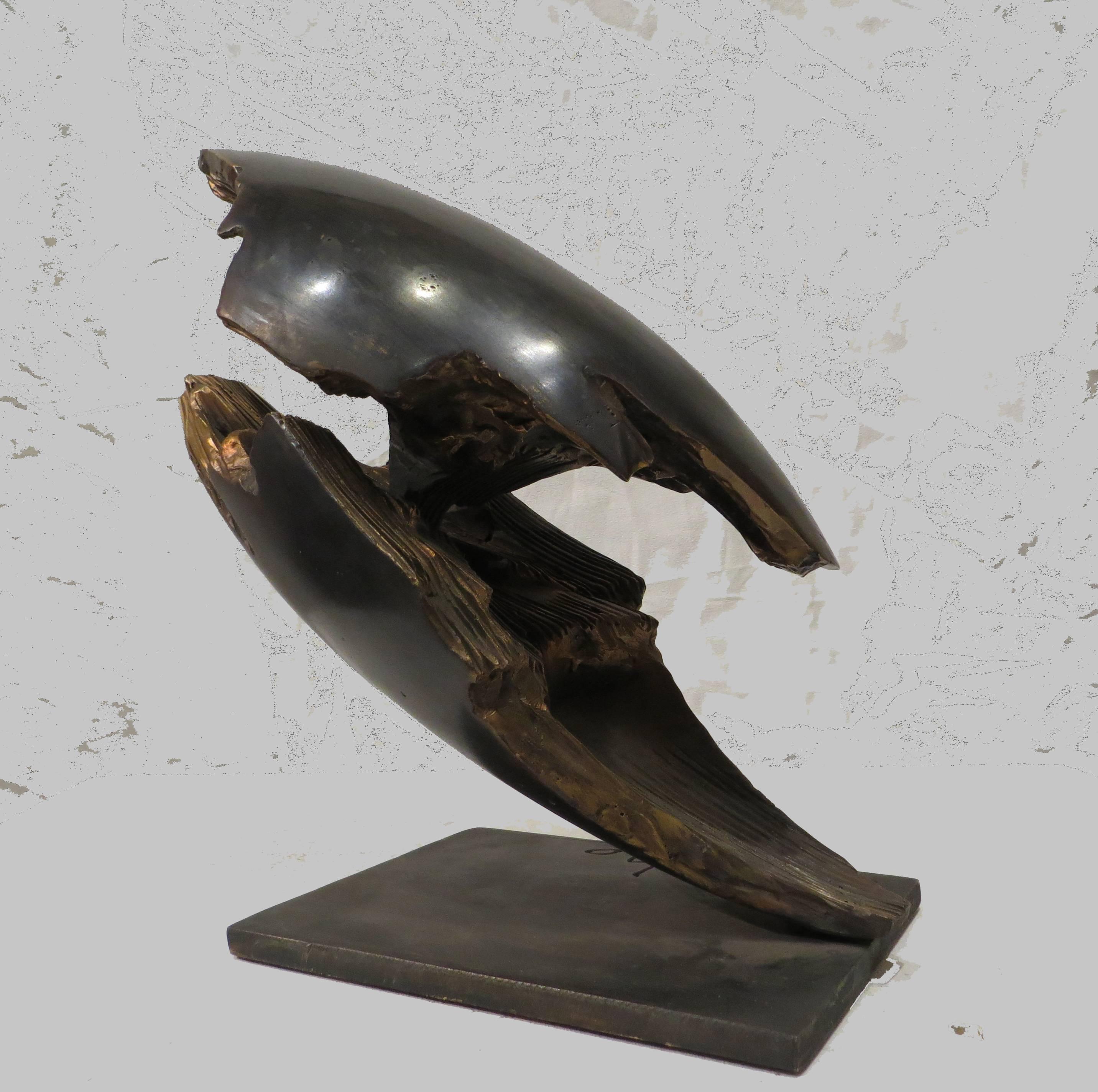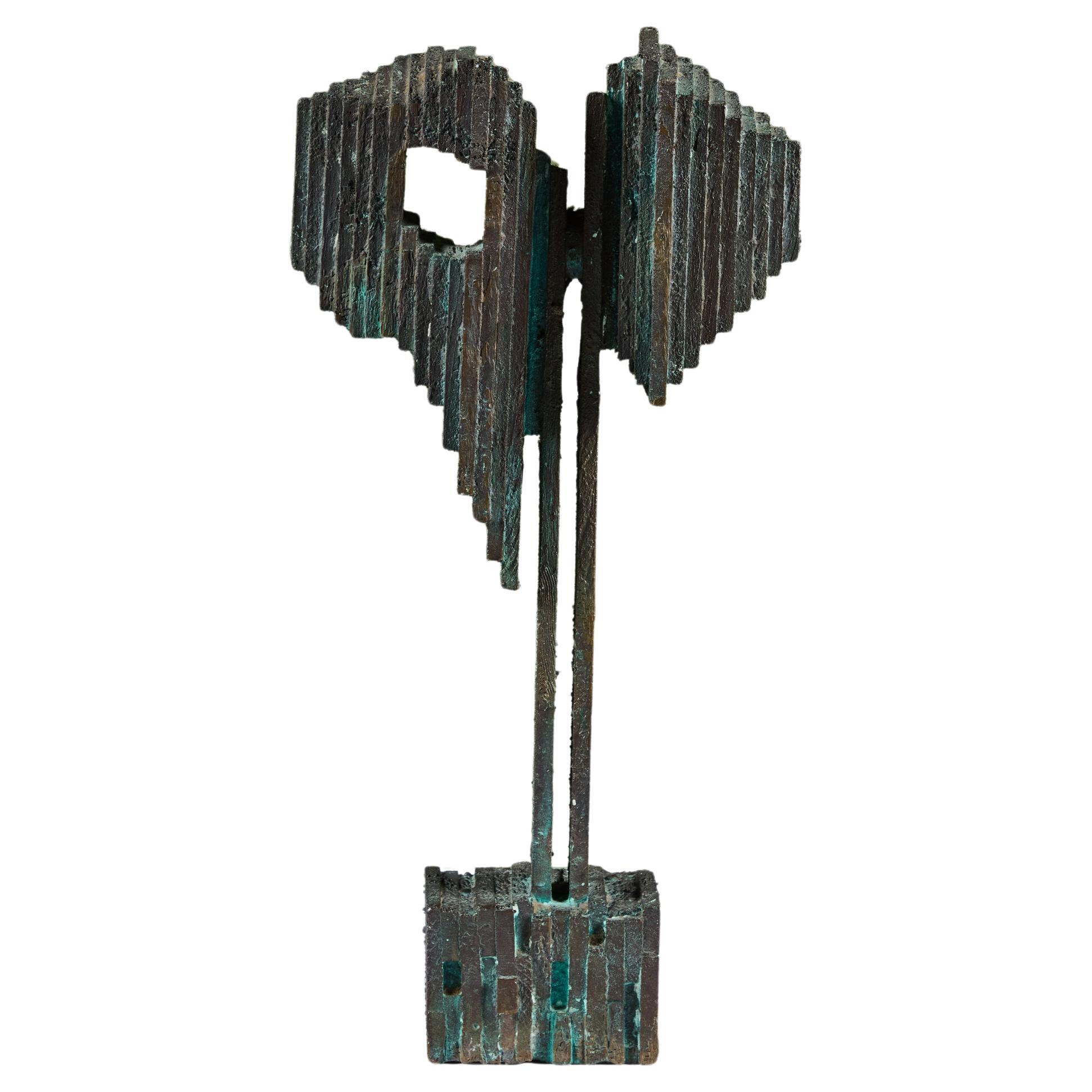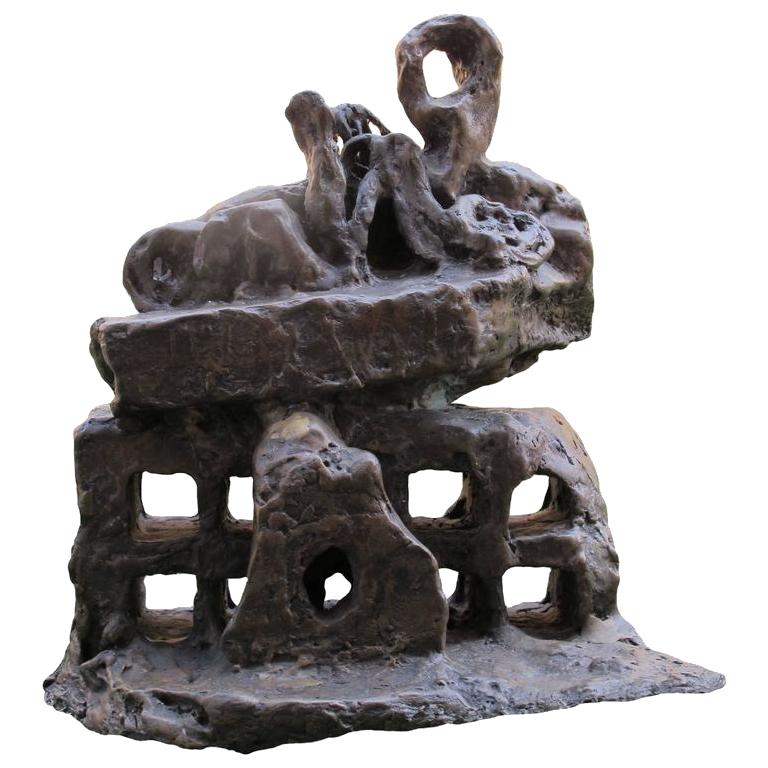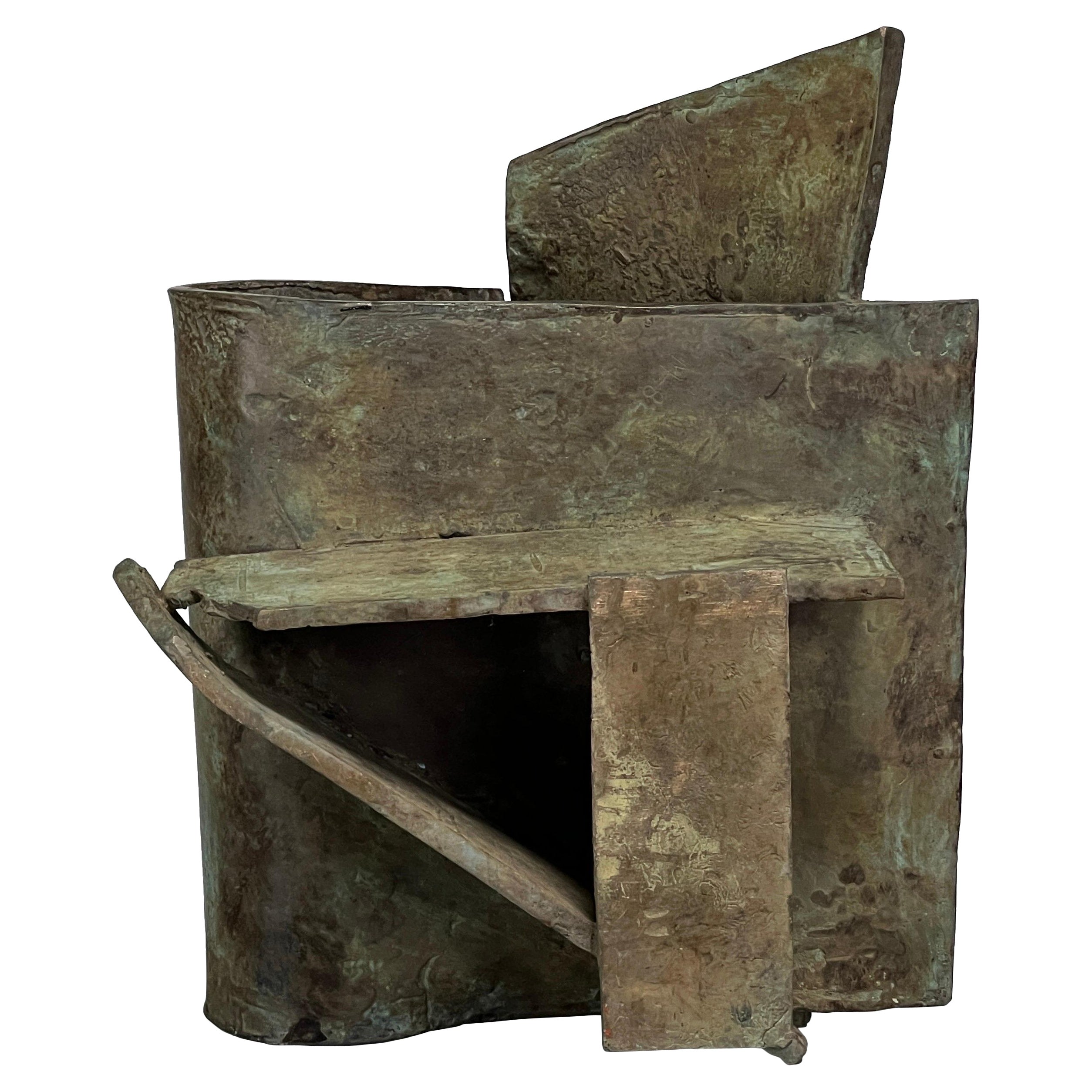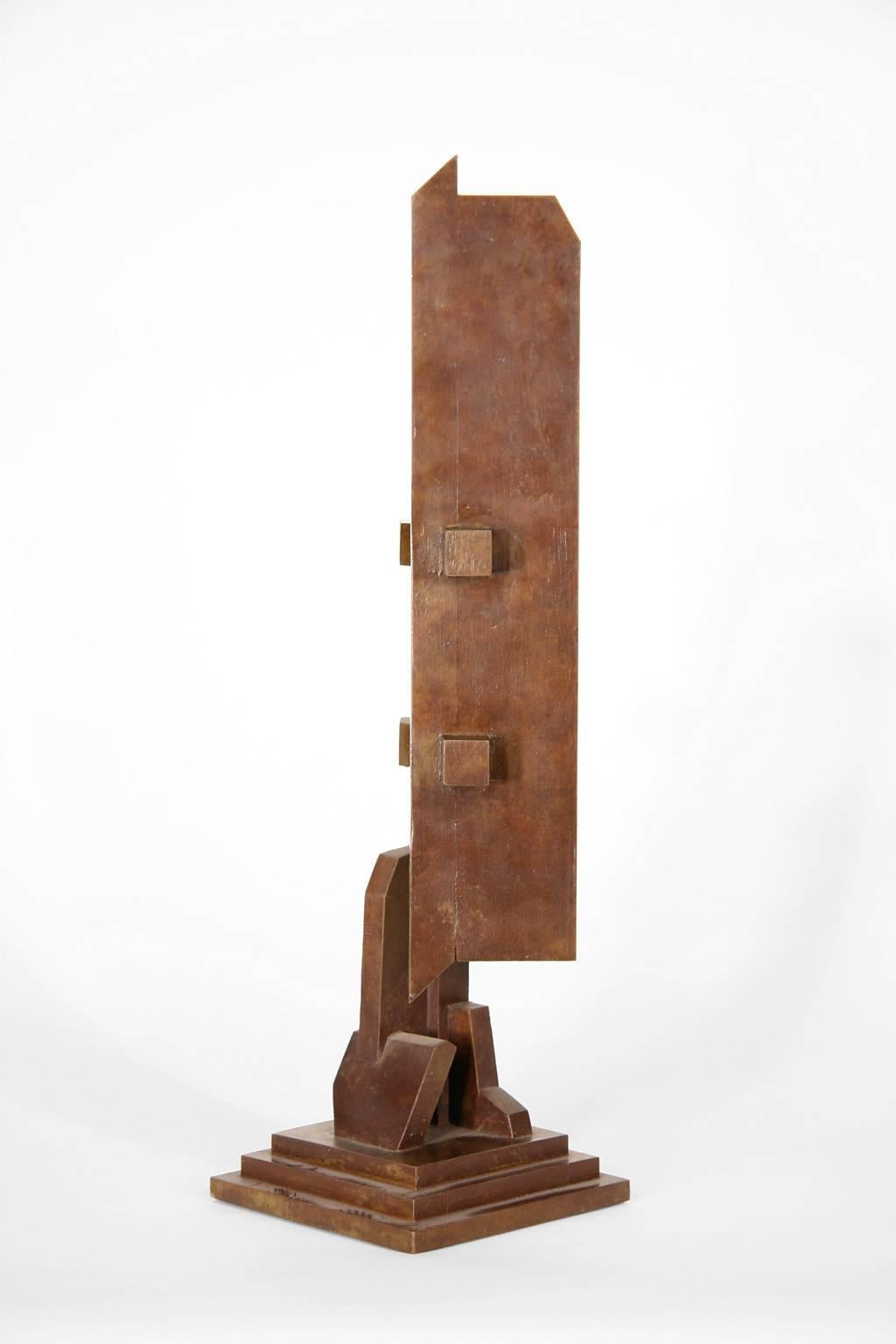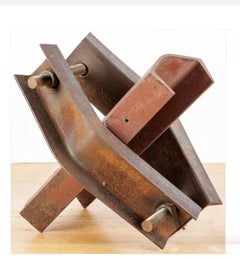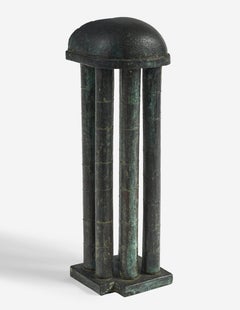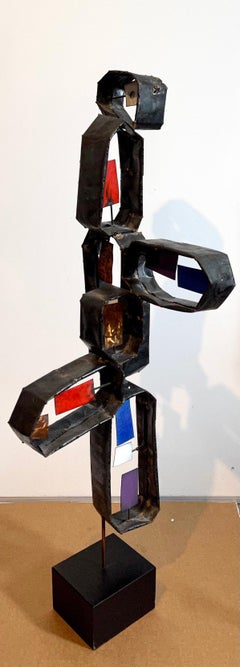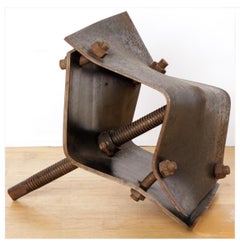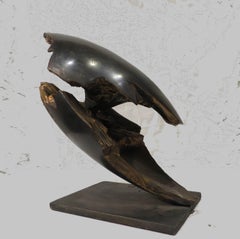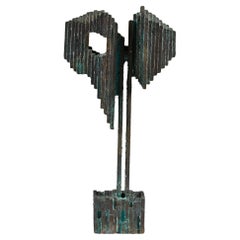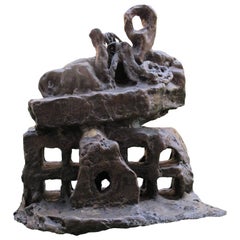Items Similar to Bronze Architectural Abstract Theater Model French Contemporary Sculpture
Want more images or videos?
Request additional images or videos from the seller
1 of 15
Guillaume CouffignalBronze Architectural Abstract Theater Model French Contemporary Sculpture2014
2014
$3,600
£2,734.79
€3,149.09
CA$5,150.16
A$5,649.23
CHF 2,913.10
MX$67,474.47
NOK 36,946.93
SEK 34,660.41
DKK 23,533.11
About the Item
Guillaume Couffignal (French b. 1964)
Theatre, 2014. Bronze.
19 7/8 x 13 1/2 x 7 1/4 inches.
Signed on the base: Couffignal. Beautiful texture and patina.
Guillaume Couffignal is a French Postwar & Contemporary self taught, outsider artist who was born in 1964. He works in bronze casting complex, fantastic, architecture models, abstract theater and boat models that look like relics from the past. He learned the art of lost wax casting with a traditional African foundry in Koudougou, Burkina Faso in Africa when he was 23, blessed to find his way so young. He felt the deep alchemy of the process combining the elements of Nature to produce a concept that did not previously exist in our world. He saw the potential of this earth magic. It forces chance and pushes the limits of bronze because each sculpture can never be exactly reproduced.
Like the use of clay, this art has a deep connection with the primitive elements of Nature. There is the wind and the sky and the earth and the fire. There are ashes and dust. Here exists a collaboration with the spirit of the Illusionist, an artist in all his unpredictability.
But it is not an art of chance. The Illusionist / artist masters the elements of accident and surprise. He is a magician who controls the secrets of his process. In the case of Couffignal, this has to do with the three-dimensional collage of carefully chosen fragments and shapes and with its earth-like textures, carefully perfected over many years of experimentation.
Its textures make the materials lie. They have an irregular patina of wear and bad weather. They make bronze itself secondary with this creamy pigmentation of the earth burnt by the sun. The texture then becomes a painting.
Couffignal sets the scene for the pure drama of the void. He fills it with memories and voices. This decor is visually minimal, but this very minimalism points to the importance of his other intentions. Its boats are "soul boats" caught between two universes. Its architectural pieces evoke ruins and nevertheless attest to their own existence.
Although this process is ancient, and in this case learned from the African tradition, the true testimony of the power of Guillaume Couffignal is that not a single element of his work derives from something existing. As a true iconoclast, he has taken up a traditional language, learned this language, and starting from this language has created a poetry completely unique and unique to him. Randal Morris, 2013. His work is from the tradition of outsider art, art brut, folk art, naïve art, visionary art and intuitive art with a sophisticated subject matter. A kind of symbiosis of jean Dubuffet and Daniel Arsham.
Sculptures as forgotten images of a world where the trace always precedes presence. As in the art of raku, ancestral Japanese pottery where the cooking accident and the patina of use - wabi and sabi - testify to an intimate cosmogonic geography. Omnipresent memory of the color and the smell of the earth - mud, noble material which in Africa is used to erect huts, houses, palaces and mosques. Historically and up to the margins of the caravan route, on the borders of the great Arabic Muslim empires of the West African Middle Ages. The earth, the color of the Sahel. Infinite variation of ocher: from the red of laterite to the white of kaolin. From drought to tropical rains. “To sculpt is to remove the flesh until you feel the skeleton, the original substance of everything, under your fingers. "
Guillaume Couffignal.
SELECT EXHIBITIONS
Spirit Codex, Cavin-Morris Gallery, New York, NY
Galerie Christine Colon, Liège, Belgium
Robin des Bois, St Léger la Montagne, France
Outsider Art Fair New York, represented by Cavin-Morris Gallery, New York, NY
Galerie Brigitte Ruffin, La Rochelle, France
Pragmata Gallery, Tokyo, Japan
ST’ART Strasbourg, Galerie Richard Nicolet, France
Salon Révélations, Grand Palais, Galerie Eric Dumont, Paris, France
Galerie Brûlée, Strasbourg, France
Fonderie Aixe-sur-Vienne, France
Galerie Christine Colon, Waremme, Belgium
- Creator:Guillaume Couffignal (1964)
- Creation Year:2014
- Dimensions:Height: 13.5 in (34.29 cm)Width: 19.88 in (50.5 cm)Depth: 7.25 in (18.42 cm)
- Medium:
- Movement & Style:
- Period:
- Condition:Good. Please see photos.
- Gallery Location:Surfside, FL
- Reference Number:1stDibs: LU38215099022
About the Seller
4.9
Platinum Seller
Premium sellers with a 4.7+ rating and 24-hour response times
Established in 1995
1stDibs seller since 2014
1,819 sales on 1stDibs
Typical response time: 1 hour
- ShippingRetrieving quote...Shipping from: Surfside, FL
- Return Policy
Authenticity Guarantee
In the unlikely event there’s an issue with an item’s authenticity, contact us within 1 year for a full refund. DetailsMoney-Back Guarantee
If your item is not as described, is damaged in transit, or does not arrive, contact us within 7 days for a full refund. Details24-Hour Cancellation
You have a 24-hour grace period in which to reconsider your purchase, with no questions asked.Vetted Professional Sellers
Our world-class sellers must adhere to strict standards for service and quality, maintaining the integrity of our listings.Price-Match Guarantee
If you find that a seller listed the same item for a lower price elsewhere, we’ll match it.Trusted Global Delivery
Our best-in-class carrier network provides specialized shipping options worldwide, including custom delivery.More From This Seller
View AllCorten Steel Sculpture Oleg Sohanievich Non Conformist Avant Garde Ukrainian
Located in Surfside, FL
Oleg Sohanievich (Soviet Ukrainian, American 1935-2017)
Corten steel, U-beams and rods Steel Stress Sculpture, 1994,
Hand signed in Cyrillic and dated 94,
Dimensions: 15" h., 16" w...
Category
1990s Post-Modern Abstract Sculptures
Materials
Steel
Bronze Architectural Model Sculpture Tempio Bretton Architecture Maquette
Located in Surfside, FL
TEMPIO BRETTON: from the catalogue MONUMENTA, 19th International Sculpture Biennale, Antwerp, Belgium.
Tempio Bretton was created in homage to the celebrated English landscapist Capability Brown for the occasion of an exhibition at Bretton Hall in the Yorkshire Sculpture Park , a park in the style of the great master of English garden design. The inclusion in the English garden of a temple ruin, or "eye-catcher," (architectural folly) was used to draw the eye and mind to a focus in time and space, present the beholder with an immediate relationship to an historic past made new within his or her own surroundings, and create a depth of space never before seen in garden design.
I took the idea of the temple ruin eye-catcher and reduced it to a scale at the point where architecture and sculpture merged. Tempio Bretton is not capacious enough to walk into, yet it is considerably larger than a man.
One view of it presents a knot of golden columns clustered together, topped by a dome shape. The only clue from this side to the temple's non-conformity to historic principle is a sharp notch cut into the square base.
Viewed from the opposite side, the cluster of columns capped by an angular top opens up as if to welcome someone in, yet the mysterious core is still impenetrable. These contradictions articulate a confrontation between past and present, and an exciting truth. The past is always at the heart of our constructions in the present.
Walter Dusenbery (born September 21, 1939 in Alameda, California) is an American sculptor. He attended the San Francisco Art Institute, earned an MFA from California College of Arts and Crafts, and then studied in Japan and Italy under Isamu Noguchi. He also held teaching positions at Harvard University and University of California, Berkeley Graduate School of Design. From 1971 to 1988, he lived both in Pietrasanta,Italy, and in Little Italy, New York City. Dusenbery's preferred material is stone, particularly travertine or granite. Dusenbery has a particular interest in adding sculpture to public places, such as federal buildings, to humanize the space, but in 1988, he assembled a show of small, entirely hand-carved alabaster sculptures, called "Walter Dusenbery, The Personal Side," at the Fendrick Gallery in Washington, D.C.. In 1977, Dusenbery created Pedogna, on permanent loan from The Metropolitan Museum of Art to Landmarks, the public art program of The University of Texas at Austin.
That same year, 1988, he was awarded a large commission for the Fulton County Building Atrium in Atlanta, Georgia. The commission was for three fountains and related structures over three stories in height, designed for informal and ceremonial public events, Limestone, marble, granite and travertine fountains, pavilions, seating and meeting areas, performance and concert platforms, staircases and planters for hanging gardens. After completion of the "Atlantacropolis," Dusenbery withdrew from the gallery world and focused his energy on site-specific commissions. (like the landscape works of Maya Lin and Beverly Pepper) Seeking a large-scale stone studio for projects closer to home, he discovered there were none. In 1995, he approached sculptor and patron of sculpture J. Seward Johnson Jr. with the idea of creating a state-of-the-art stone-carving studio, so that American sculptors would not have to travel abroad to realize their work. Johnson agreed to fund such a facility, if Dusenbery would direct it. In 1996, Dusenbery designed the facility for the Stone Division at Johnson Atelier Technical Institute of Sculpture, and was its first director. The facility was situated in "a building resembling an airplane hangar," The studio offered the ability to digitally scan three-dimensional forms. The Stone Division was a success and attracted a strong group of sculptors: Magdalena Abakanowicz, Lawrence Argent, Barry X Ball...
Category
20th Century American Modern Abstract Sculptures
Materials
Bronze
Italian Mid Century Mod Large Brutalist Welded Copper Enamel Sculpture Wood Base
Located in Surfside, FL
Welded, brazed, copper (based on the weight, this might be iron or bronze) with colorful inset enamel plaques on a painted wood base. A studio handmade Brutalist sculpture in a mann...
Category
Mid-20th Century Abstract Abstract Sculptures
Materials
Metal, Copper, Enamel
Corten Steel Sculpture Oleg Sohanievich Non Conformist Avant Garde Ukrainian
Located in Surfside, FL
Oleg Sohanievich (Soviet Ukrainian, American 1935-2017)
Steel Stress Sculpture #3, 1982,
Hand signed and dated Oleg Sohanievich '82
Dimensions: 17" h., 23" w., 16" d.
Very heavy
Th...
Category
1980s Post-Modern Abstract Sculptures
Materials
Steel
Brutalist Bronze Abstract Modernist Sculpture
Located in Surfside, FL
In the manner of Julio Gonzalez, mixed metal sculpture.
Neo-Dada Abstract Sculpture: Assemblages
Abstract sculpture followed a slightly different course. Rather than focusing on no...
Category
20th Century Abstract Expressionist Abstract Sculptures
Materials
Bronze, Copper
Mid Century Brutalist Iron, Stone Sculpture, Israeli Master David Palombo
By David Palombo
Located in Surfside, FL
Hand Forged Iron and Drilled Stone Candelabra
Holocaust Memorial Judaic Menorah Sculpture
David Palombo was an Israeli sculptor and painter. He was born in Turkey to a traditional family and immigrated to the Land of Israel with his parents in 1923. They lived in the Nahalat Shiva neighborhood of Jerusalem. In 1940 he began his studies at Bezalel Academy of Arts and Design, and from 1942 was a student of sculptor Ze’ev Ben-Zvi. For a period of time, Palombo was an assistant at Ben-Zvi’s studio and also taught at Bezalel. During this period he was also a member of the “Histadrut HaNoar HaOved VeHaLomed” (The General Federation of Students and Young Workers in Israel). In the 1940s he took art lessons at night. In 1948 he went to Paris, where he visited the studio of the sculptor Constantin Brancusi whose work influenced him. Around 1958 he married the artist Shulamit Sirota. In 1960 he quit his job to devote himself to art. In 1964 he married for the second time to the artist Yona Palombo. The two of them went to live in an abandoned home on Mount Zion in Jerusalem. In 1966 he was killed when the motorcycle on which he was riding ran into a chain stretched across the street to prevent the desecration of Shabbat. His widow opened a museum in their home that was active until the year 2000.
Work by Palombo is included in the Judaic collection of the Jewish Museum (a well known Hanukkah menora). Palombo executed the impressive metal gates of the Tent of Remembrance at the Yad Vashem, the memorial to the martyrs of the holocaust, as well as the gates to the Knesset Building the United Nations Educational Scientific and Cultural Organization (Unesco award) awarded him a scholarship for study in Japan. He worked in marble, granite, bronze, iron and steel. as well as with glass mosaic tiles. Palombo’s early works, in the 1950s, were influenced by modernist sculptors such as Brancusi. These works were composed of abstract images from nature and were carved out of stone or wood. At the end of the 1950s he began making metal sculptors, using the technique of welding. His work took on a more abstract and expressive character.
Education
1940 Painting with Isidor Ascheim, New Bezalel School for Arts and Crafts, Jerusalem
1942 Sculpture with Zeev Ben Zvi, Jerusalem
1956 Mosaic, Ravenna, Italy
1958 Welding Course
Awards And Prizes
1966 UNESCO Award
Exhibitions:
Sculpture in Israel, 1948-1958 Mishkan Museum of Art, Kibbutz Ein Harod
Artists: Zvi Aldouby, Yitzhak Danziger, Arieh Merzer, Dov Feigin, Aaron Priver, David Palumbo, Menashe Kadishman, Kosso Eloul, Yehiel Shemi, Zahara Schatz.
The Spring Exhibition of Jerusalem Artists, Artists' House, Jerusalem
Artists: Palombo, David Bezalel Schatz, Mordechai Levanon, Fima, Ludwig Blum
12 Artists, The Bezalel National Museum, Jerusalem
Avraham Ofek, Aviva Uri, Avigdor Arikha, Yosl Bergner, Lea Nikel, Palombo, Ruth Zarfati,
General Exhibition, Art in Israel 1960 Tel Aviv Museum of Art
Artists: Naftali Bezem, Nachum Gutman, Shraga Weil, Shraga, Marcel Janco, Ruth Schloss
Category
Mid-20th Century Arte Povera Abstract Sculptures
Materials
Stone, Iron
You May Also Like
Bronze Sculpture EXCLOS
By Guillaume Roche
Located in Pasadena, CA
Guillaume ROCHE
The artist translates movement and energy through the dynamism of assemblages and seeks the balance of composition. His sculptures offer aerial movements, round shapes with powerful lines, delicate and sensual cuts.
The contextualization of his works, inscribing the approach of Guillaume Roche in the field of architecture: work of structure, lines, matter and skin, study of a volume and its proportions according to context and environment. His work is conceived to be connected with the territory. The EXCLOS series is born from the encounter of the concepts of EXPLOSION and ECLOSION. The artist conceives these imposing spheres of steel as a powerful breath contained by a gentle force that channels and envelops this primary energy.
Working with stainless steel, Guillaume seeks contrast through concepts such as full-void, light-weight, balance-fall. In contrast, he finds total freedom of creation...
Category
Early 2000s Abstract Geometric Abstract Sculptures
Materials
Bronze
$5,708 Sale Price
20% Off
Abstract Bronze Sculpture
Located in Los Angeles, CA
Bronze mounted abstract sculpture. The sculpture showcases a square base and narrow stem that expands outwards to the right and left showcasing a layered look. One side appears to be...
Category
Mid-20th Century American Mid-Century Modern Abstract Sculptures
Materials
Bronze
Container by Romain Langlois - Wood-like sculpture, golden bronze interior
By Romain Langlois
Located in Paris, FR
Container (2014) is a work by contemporary French artist Romain Langlois.
Bronze, 39 cm × 106 cm × 26 cm. Edition of 8 & 4 A.P.
In this bronze sculpture, Romain Langlois has produce...
Category
2010s Contemporary Abstract Sculptures
Materials
Bronze
Bronze Sculpture "Sortie De Chaos Aux Mots Éclatés" 2005, by Catherine Val
By Catherine Val
Located in Saint-Ouen, FR
Bronze, got foundry, 2/8, signed.
Bibliography: Double sortie de chaos, page 8.
Category
21st Century and Contemporary French Abstract Sculptures
Materials
Bronze
Abstract Bronze by Michael Steiner
By Michael Steiner
Located in Dallas, TX
The twisting plains of this 1976 Michael Steiner bronze create a quiet tension on a small scale. Mr. Steiner's work is represented in the permanent collections of the Solomon R. Gugg...
Category
Vintage 1970s American Abstract Sculptures
Materials
Bronze
"1099", Richard Heinrich, Abstract Contemporary Bronze Sculpture, Metal
By Richard Heinrich
Located in New York, NY
"1099 Maquette" by Richard Heinrich, 1999
Bronze
Contemporary Abstract Sculpture, Industrial, Modern, Indoor, Outdoor
Category
2010s Abstract Abstract Sculptures
Materials
Bronze
